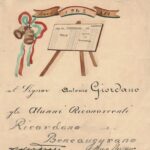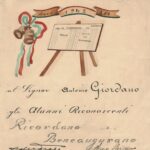Hand-drawn Christmas card with the message ‘Buon Natale’.
History
The card was given to Mr Antonio Giordano in 1942 by members of the Italian group interned in Number Nine Loveday Internment Camp near Barmera, South Australia, during the Second World War. Mr Giordano was born in 1907 at Naples, Italy, and migrated to Australia in 1924, aged seventeen. Prior to the outbreak of the war, he worked variously as a labourer in Victoria and NSW, in catering, in radio and as a journalist for Il Giornale and the Italo Australiano. He mainly wrote feature articles for the Italo Australiano, and also had his own column, in which he often expressed opinions hopeful of Italy not entering the war. When this did happen in 1940, Mr Giordano was arrested as an ‘enemy alien’ at his Potts Point flat in NSW. While getting dressed the police searched his flat and took a few things of apparent interest to them. He was told the rest of his possessions would be taken care of, but apart from a few clothes and books, he never saw any of his possessions again. Most importantly, he lost the draft of a book he was working on. Mr Giordano was to spend the next four years in internment camps at Orange, Hay (both in NSW), and Loveday (SA).
After being released at the end of the war, Mr Giordano was initially sent to Morgan, South Australia, as a timber-cutter. Eventually, he continued his work in journalism, as well as working as an interpreter, a restauranter, and in Italian-Australian commerce, club soccer, and migrant welfare. He also wrote and contributed to several books on early Italian naval explorers who travelled through the Asia-Pacific region. Mr Giordana died in 1984, highly respected by those both part of and outside the Italian community in Australia.
Significance
Many of the inmates held at Loveday Internment Camp were skilled workers or professionals. They undertook work activities during the day, including cultivation of food crops and medicinal plants. During leisure hours, they found ways of entertaining themselves, including making things like this Christmas card. The card demonstrates how internees marked special occasions and attempted to maintain some semblance of normal life.
Description
This christmas card has been hand-printed on thin, white, light-weight paper, and folded in half. When opened, the left-hand page features a poem written in Italian, in black ink, on lines ruled with pencil. The right-hand page has twelve signatures also signed in black ink. At the top of the front cover is written ‘Buon Natale’ (Merry Christmas) in calligraphic black ink, above a watercolour paint depiction of a ledger with Christmas bells and ribbons, using brown, red and green. The bottom half of the page contains another Italian sentence written in black ink, plus two signatures above the signatories’ titles or positions, which have been printed using a typewriter.






Comments